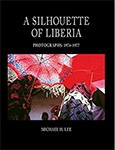Review — A SILHOUETTE OF LIBERIA by Michael Lee (Liberia)
 A Silhouette of Liberia — Photographs: 1974-1977
A Silhouette of Liberia — Photographs: 1974-1977
by Michael H. Lee (Liberia 1974–76)
Michael H. Lee
August 2017
136 pages
$59.99 (hardcover)
Reviewed by: Danielle Yoder (Panama 2012-2014)
•
A Silhouette of Liberia Photographs: 1974–1977 exhibits beautiful photography of Liberia’s landscape, architecture and people from a time when very little has been preserved. Mr. Lee walks us through his experience living, serving and working in Liberia. Through his lens he is able to capture what one might see in an ordinary day in Liberia, as well as intimate settings such as illusive secret societies and their traditions.
Mr. Lee begins by providing some history of the country that informs both the conditions of the photographs shown from the mid-70s and also alludes to the impending civil war period. These shots show mostly friendly faces as well as typical living conditions and hardships born by denizens. I was surprised how similar these images look to the streets of Monrovia in 2017. Forty years have passed but so little has changed.
The tale continues with upcountry shots of one of the main county capitals, Gbarnga, and other, more remote villages. While Monrovia’s urban population is demonstrated by small shacks, crowded markets of panhandlers and some homeless on the street, the photographs of the countryside illustrate the pastoral aspects of Liberia’s rural population. Upcountry images include farming methodologies in Liberia’s lush rainforest, huts built of entirely natural materials and political and cultural activities.
Deeper upcountry, Mr. Lee delves into some of Liberia’s fabled secret societies. Of course the traditions of such societies are not readily shared with outsiders and much of the information is speculative in nature. These photos and stories, however, do provide some insight into the potential rituals and rites that may be celebrated in these rural communities and demonstrate how seriously these rituals are protected by their members.
The story culminates with a study on the architecture of the original Americo-Liberians. These buildings are almost surely no longer standing after the civil wars. As of the 1970s, these homes had withstood over 90 years of the harsh rains of Liberia. Mr. Lee’s discussion on the architecture provides an insight into the unique history of Liberia’s past.
Overall, Mr. Lee provides a snapshot into Liberia’s history about which so little has been written and shared. Although much of Liberia’s history has been lost due to wars, the remnant and memories that remain are quite beautiful. This was a beautiful way to share Liberia’s culture and leaves the reader hungry for more information and a desire to visit and see for one’s self the beauty and cultures that remain today.
•
Reviewer Danielle Yoder is an RPCV who served in Panama from 2012-2014.
Recently she returned from a one-year work assignment in Monrovia, Liberia and was captivated by the chance to review this book. So little is documented about Liberia’s history and it has a rather fascinating one. She currently resides in Philadelphia with her husband and daughter.
No comments yet.
Add your comment